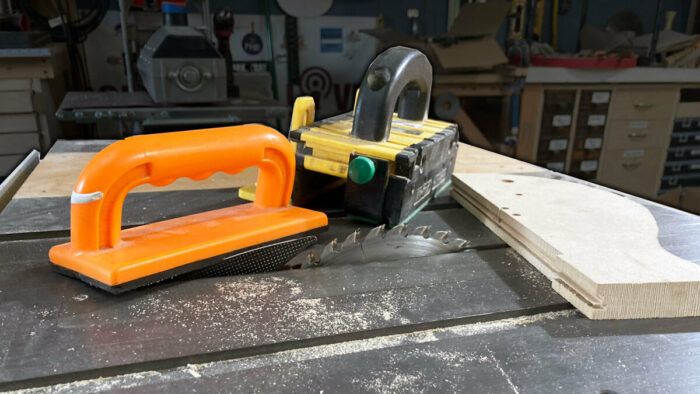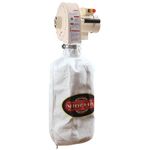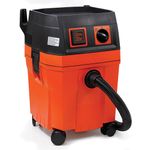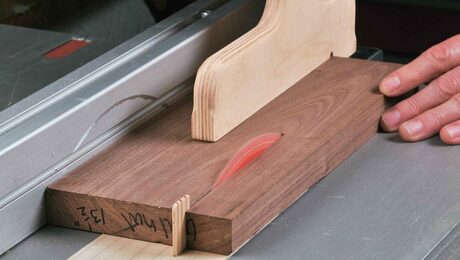Don’t be unsafe
Time-tested methods might not be sexy in the social-media world, but they will keep your limbs intact.
Ah, the internet. A never ending abundance of information—some of it good and a lot of it bad. Recently I’ve seen a lot of power tools and machines being used inappropriately and it’s quite concerning. Many “influencers” do things on their pages to garner likes and subs (that’s the way the cool kids say “subscribers”), and in many cases in order to do this, they have to come up with something new to show people.
Don’t do it for the views
An example that I saw recently was a video demonstrating how to cut a circle using a table saw. Yes, a table saw. The technique involves making a sled with a pin to “hold” the work. You are meant to make a cut, then rotate the piece, repeating these steps over and over until the waste is removed and you can spin the wood freely against the spinning sawblade. In this particular video, the blade grabbed the board and spun it, dragging the user’s hand into the spinning blade. Had the influencer not had a SawStop, this would have turned their hand into a pack of hamburger and they would have been just another table saw safety statistic. And for what? Views? Notoriety?
I personally don’t have a table saw in my shop, but I’ve got nothing against them. It’s just that there are many safer ways to create a circle using woodworking tools—ways that are safer but alas, not new, so they may not get the external affirmation that the user was looking for.
Trust the tried and true
So let’s talk wood circles for a moment. Now, to be fair, I don’t often have to make a circle in woodworking. In fact, other than a couple of round tabletops I’ve not needed to cut a circle. Arcs and curves yes, but not a circle. That being said, if I needed a circle I would complete the job in a much more practical and safe way. As a woodworker with both hand and power tools, I would immediately head to the bandsaw and cut it out freehand or with a circle-cutting jig. I could then refine the cut with a hand plane or a disc sander. I could use a router bit and trammel to create the circle, or I could use the router to create a template. I could then cut out the circle oversized with a jigsaw then use the template with a bearing-guided straight bit to clean it up.
If you are a dedicated hand-tool user, you could mark your circle and cut it out with a bow saw, then refine the shape using a block plane or a flat spokeshave. You could also use a wide chisel, bevel down, to transform a square into a circle.
Better safe than sorry
Without thinking too hard, I have just provided five methods to create a circle that are safer, more efficient, and less terrifying than nibbling away at a bit of wood with a table saw. Many readers find woodworking an enjoyable hobby, so why would you risk serious injury for something that is a pastime? Nor would a professional who makes a living with woodworking risk their livelihood by working in an unsafe manner.
The truth is, all woodworking can be unsafe, but if you’re about to do something that makes you feel funny in the pit of your stomach, please pause and reconsider what you are doing. Work using tried and tested techniques and you’ll be at it for years to come.
More from Vic Tesolin
 |
No meat in front of the blade |
 |
Who needs a table saw? |
 |
The power of the center line |
Fine Woodworking Recommended Products

Rockler Dust Right 1250 CFM

Shop Fox W1826

Fein Turbo II HEPA Wet/Dry Dust Extractor






















Comments
Great story Vic but from the beginning I kept think I had seen this movie before and maybe in the pages of FWW. I too have used a bandsaw and or router for the one or two circles I have ever needed to cut. But somewhere in the last ten years or so ago I saw someone with something like a circle jig for a band saw on a table saw turning a piece of wood against a spinning blade to get it round and thought the same thing you did. Where ever I saw it I remember thinking, WOW of all the ways to do that! And why would they even offer that idea to the public.
I always look forward to your work.
BE SAFE and have fun
Feeling a bit blunt and so also frank, I feel the notion of "time tested [safety] methods" might also be questioned. Basically, the more "traditional" methods of operating dangerous WW tools shown, not just at influencers' corner but also on well-established and trusted WW websites (including this one) often include what seem to my inherent risk assessor to be "unwise".
In particular, most demos on such websites still show unguarded blades, hands used as feather boards and the pushing of hands towards dangerous parts until they're just an inch away from the thing that will mangle them.
Tablesaw use in a highly risky fashion seems the norm. Many "standard" practices with routers, particularly router tables, look as risky.
It's telling that the US sees the sawstop as the best means to table saw safety. The nature of the protection offered assumes (perhaps even allows) that the user will stick their hand into the blade eventually. Personally I feel that the European approach to preventing hands going into blades is a far better road to safe practice, since those methods seek to prevent the hand ever touching the rotating blade in the first place. And they work with all saws, not just very expensive ones with very expensive safety devices that need replacing when a blase dafty sets them off again and again.
*********
Underlying causes of a widespread ignoring (and perhaps ignorance) of WW risks seems to be largely generated by a combination of macho attitudes ("Don't need no steenkin' safety") and the mantra that doing things rapidly but casually shows skill. Neither is a useful approach to remaining safe in a WW shed.
In short, a lot of "tried and true" safety procedures seem more like a pose than a real preventative.
My first thought was FWW but Rockler has one of their simplistic videos showing it, based on an article in Woodworkers Journal. It's really easy, folks!
Log in or create an account to post a comment.
Sign up Log in